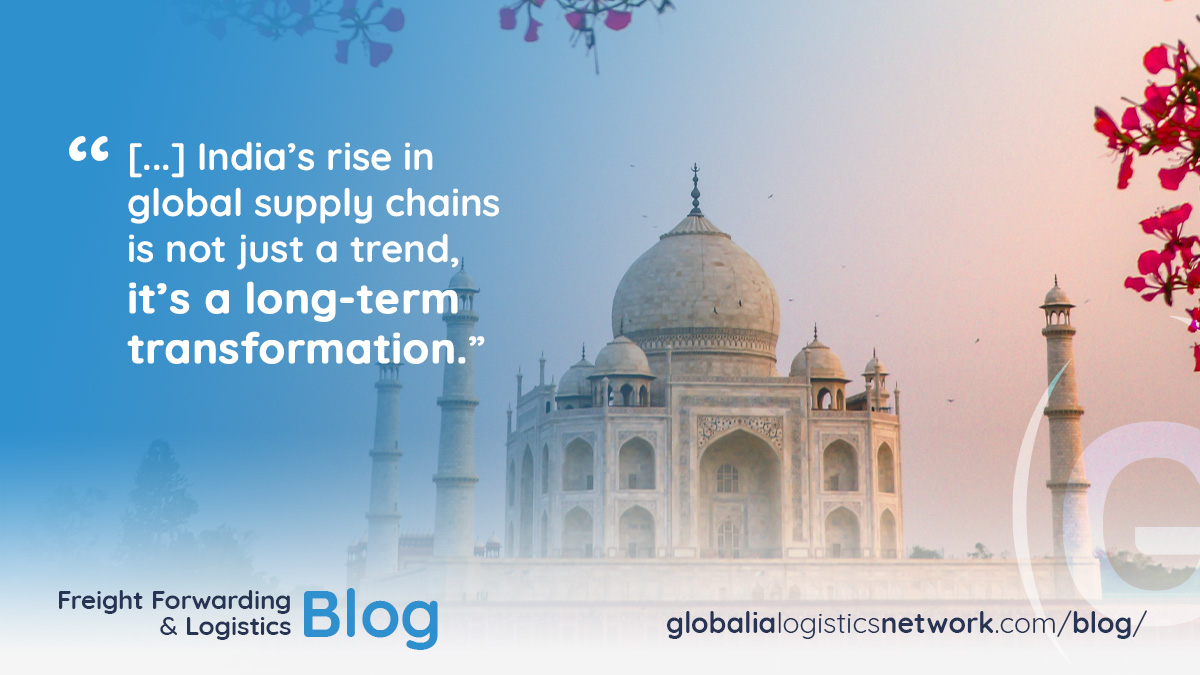Global trade is in constant flux, and right now, India is quickly emerging as a powerhouse in global supply chains. From policy reforms to massive infrastructure projects, the country is positioning itself as a central player in international logistics. For freight forwarders in India, this isn’t just good news—it’s a huge opportunity. Let’s break down what’s happening, why it matters, and how forwarders can make the most of it.
India’s Logistics Push: Policy Meets Potential
In the past decade, India has gone from being known as a market for cheap labor and outsourcing to a hub for manufacturing and logistics. The Indian government’s National Logistics Policy (NLP) launched in 2022, aims to bring down logistics costs from 13–14% of GDP to a globally competitive 8%.
That’s not just a statistic—it’s a complete reimagination of how goods move through India. The government is pumping investment into roads, railways, ports, and airports, creating multimodal connectivity that directly impacts the day-to-day operations of freight forwarders.
Take the Dedicated Freight Corridors (DFC) as an example. These rail freight corridors, once fully functional, will reduce transit times between major industrial hubs by almost half. Imagine the efficiency boost when cargo can move from Dadri near Delhi to JNPT Port in Mumbai in under 24 hours instead of 48+.

Infrastructure Investments: Ports, Airports, and Beyond
India is putting serious money into logistics infrastructure. The Sagarmala Project is modernizing ports and improving coastal connectivity, while Bharatmala is building 35,000 km of highways to speed up inland transport.
On the air cargo side, Delhi International Airport Limited (DIAL) has built one of the largest cargo terminals in South Asia, handling nearly 1.5 million metric tons annually. Meanwhile, Bangalore Airport has emerged as India’s leading perishable cargo hub, crucial for industries like pharma and fresh produce.
For freight forwarders in India, these developments mean faster turnaround times, greater reliability, and access to more specialized facilities. Whether you’re handling e-commerce, auto parts, or pharmaceuticals, the playing field is expanding.
Why Global Players Are Looking at India
Companies are diversifying supply chains due to rising costs in China and the geopolitical risks of putting “all eggs in one basket.” This shift, often dubbed the “China+1” strategy, has turned India into a serious contender for global manufacturing and sourcing.
Just look at Apple’s decision to ramp up iPhone production in India. Over 7% of iPhones are now assembled there, and that figure is expected to grow significantly. When global brands move manufacturing, logistics naturally follows. Forwarders who can adapt quickly to these changes are the ones who stand to benefit.
Similarly, Amazon and Flipkart have scaled up their warehousing and logistics operations in India, signaling confidence in both domestic and export potential.
Opportunities and Challenges for Freight Forwarders in India
Here’s the thing: opportunities are massive, but challenges still exist. India is notorious for red tape, varying state-level regulations, and occasional infrastructure bottlenecks. Customs clearance can sometimes be unpredictable, although digitization efforts are improving this.
The Unified Logistics Interface Platform (ULIP) is designed to make processes more seamless by integrating data from multiple government agencies. Once fully operational, it will save hours, if not days, for forwarders dealing with cargo documentation.
For freight forwarders in India, this mix of growth and growing pains is where strategy matters most. Those who build strong international networks, leverage technology, and specialize in key verticals like pharma or automotive will be the ones who truly thrive.
Case Example: Pharma Logistics in Hyderabad
Hyderabad, often called “Pharma City,” is home to India’s largest pharmaceutical industry cluster. During the pandemic, the city’s logistics network played a crucial role in vaccine distribution worldwide. Companies that had international partnerships were able to scale up and move cargo across continents seamlessly.
This case highlights the importance of being globally connected. Freight forwarders who had established ties with overseas agents could support vaccine distribution in real time, while smaller players without such connections were left behind.
Case Example: Auto Exports from Chennai
Chennai has earned the nickname “Detroit of Asia,” exporting cars and auto components to over 100 countries. Logistics companies operating here benefit from dedicated automobile terminals at the Chennai Port, along with strong rail connectivity to industrial hubs. Forwarders who carved out a niche in automotive logistics saw their business grow even during economic slowdowns. Again, global connectivity was key, cars assembled in Chennai had to be shipped to Latin America, Europe, and Africa without delays.
How Freight Forwarders in India Can Ride This Wave
So what does all this mean for you as a freight forwarder? It means now is the time to expand your reach, strengthen your global ties, and embrace technology. India’s logistics boom is real, but without international partnerships, the benefits are limited.
This is where joining a reliable freight forwarders’ network like Globalia Logistics Network becomes critical. Globalia offers exclusivity—only one forwarder per city so you get all the local business opportunities without direct competition inside the network. Their FreightViewer software makes quoting and managing shipments easier, which is vital in a fast-moving market like India.
And let’s not forget the Annual Meeting, where members from across the globe meet face-to-face, discover new project opportunities, and solidify partnerships. For freight forwarders in India looking to go international, this is a shortcut to building trust and credibility with overseas partners.
Join us before your territory is taken!
Final Thoughts
India’s rise in global supply chains is not just a trend, it’s a long-term transformation. With infrastructure upgrades, policy reforms, and global companies betting big on Indian manufacturing, the logistics sector is set to thrive. For freight forwarders in India, the opportunity is clear. By staying ahead of infrastructure changes, specializing in high-growth industries, and joining a trusted network like Globalia, you can scale your operations and connect with reliable partners worldwide. The future of logistics in India is bright. The only question is: are you ready to make the most of it?


